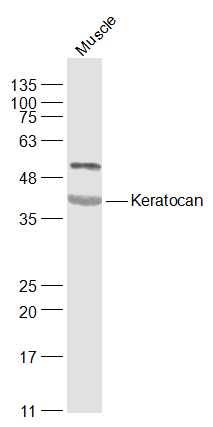
Rabbit Anti-Keratocan antibody
CNA2; KERA; KERA_HUMAN; Keratan sulfate proteoglycan keratocan; Keratocan; KTN; SLRR2B.
View History [Clear]
Details
Product Name Keratocan Chinese Name 细胞角膜蛋白多糖抗体 Alias CNA2; KERA; KERA_HUMAN; Keratan sulfate proteoglycan keratocan; Keratocan; KTN; SLRR2B. literatures Research Area Neurobiology Signal transduction Cell adhesion molecule Extracellular matrix Immunogen Species Rabbit Clonality Polyclonal React Species Mouse, (predicted: Human, Rat, Dog, Pig, Cow, Horse, Sheep, ) Applications WB=1:500-2000 ELISA=1:5000-10000
not yet tested in other applications.
optimal dilutions/concentrations should be determined by the end user.Theoretical molecular weight 38kDa Cellular localization Extracellular matrix Secretory protein Form Liquid Concentration 1mg/ml immunogen KLH conjugated synthetic peptide derived from human Keratocan: 201-300/352 Lsotype IgG Purification affinity purified by Protein A Buffer Solution 0.01M TBS(pH7.4) with 1% BSA, 0.03% Proclin300 and 50% Glycerol. Storage Shipped at 4℃. Store at -20 °C for one year. Avoid repeated freeze/thaw cycles. Attention This product as supplied is intended for research use only, not for use in human, therapeutic or diagnostic applications. PubMed PubMed Product Detail Small leucine-rich proteoglycans (SLRPs) such as Decorin, Biglycan, Fibromod-ulin, Keratocan, Lumican and Osteoglycin mediate extracellular matrix organization and are binding partners of TGF Beta. The Decorin core protein binds to growth factors, intercellular matrix molecules such as Fibronectin and Throm-bospondin, and to the Decorin endocytosis receptor. Fibromodulin is a collagen-binding keratan sulphate proteoglycan that influences adhesion processes of connective tissue and plays a role in fibrillogenesis by regulating collagen fibril spacing and thickness. Keratocan (KTN) develops corneal transparency and maintains the stromal matrix structure. Keratocan is a secreted protein in the extracellular matrix that binds to keratan sulfate chains. Keratocan is mainly detected in the cornea, but can also be expressed in trachea, intestine, ovary, lung and skeletal muscle. Defects in the gene encoding for Keratocan can cause cornea plana 2 (CNA2), an autosomal recessive disorder where the forward convex curvature of the cornea is flattened.
Function:
May be important in developing and maintaining corneal transparency and for the structure of the stromal matrix.
Subcellular Location:
Secreted > extracellular space > extracellular matrix.
Tissue Specificity:
Cornea. Increased expression in the stroma of keratoconus corneas. Also detected in trachea, and in low levels, in intestine, skeletal muscle, ovary, lung and putamen.
DISEASE:
Defects in KERA are the cause of the autosomal recessive cornea plana 2 (CNA2) [MIM:217300]. In CNA2, the forward convex curvature is flattened, leading to a decrease in refraction, reduced visual activity, extreme hyperopia (usually plus 10 d or more), hazy corneal limbus, opacities in the corneal parenchyma, and marked arcus senilis (often detected at an early age). CNA2 is a rare disorder with a worldwide distribution, but a high prevalence in the Finnish population.
Similarity:
Belongs to the small leucine-rich proteoglycan (SLRP) family. SLRP class II subfamily. Contains 10 LRR (leucine-rich) repeats. Contains 1 LRRNT domain.
SWISS:
O60938
Gene ID:
11081
Database links:Entrez Gene: 11081 Human
Omim: 603288 Human
SwissProt: O60938 Human
Unigene: 125750 Human
Product Picture
Bought notes(bought amounts latest0)
No one bought this product
User Comment(Total0User Comment Num)
- No comment



 +86 571 56623320
+86 571 56623320
 +86 18668110335
+86 18668110335

